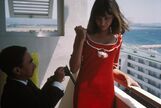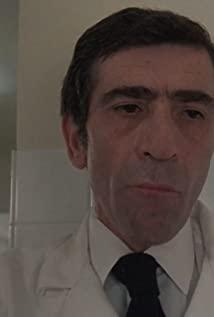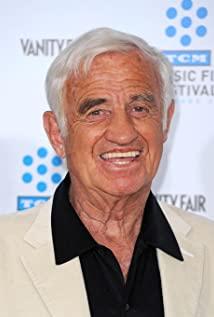"This is a work about love, hurt, and in short, emotions." This actually comes from what the American director said when Ferdinand was chatting with the American director when he was participating in a boring party. Mouth expressed his thoughts.
The male protagonist Ferdinand is a person who likes to think, ethereal and uncaring, while the female protagonist Marilyn is a positive, enthusiastic character inclined to enjoyment and sensuality. In fact, it can be seen from the beginning that they are not suitable, so the ending is predictable. It is also ironic that the only time the male protagonist Ferdinand wants to take the initiative to do something is already at the end of the film - he wants to extinguish the detonator, but there is no time, so this ending occurs.
In order to understand a work, we must have a certain understanding of the author, especially in what kind of environment and what kind of mentality the author produced this work.
In the summer of 1959, Godard saw Anna Karina at the age of 17 in a TV soap commercial. She was shocked and decided to play a role in "Exhausted", but the shy Karina. However, he expressed his unwillingness to expose his body in front of the camera. Of course, Godard, who has a strong personality, will not modify the script because of this, and the cooperation will come to nothing. Three months later, Godard already had his own film company. Unwilling to give up, he asked Karina to play the heroine of "Little Soldier" again. Karina asked suspiciously, "Sir, this time I have to take off the film. Is it?" Godard replied: "Not at all, this time is a political movie." Most of the scenes in "Little Soldiers" involve the heroine, and they are reluctantly playing eye-catching salutes. The arrangement of the back of the head and even the structure of the film have had a negative impact. Godard is worthy of being a romantic French in his bones. What is a mere movie? A beautiful woman's heart is a priceless treasure. At the end of 1960, Karina and Godard collaborated on the filming of the colorful musical "A Woman is a Woman". The lighthearted and witty plot seemed to imply the rapid heating of their relationship. During the filming, Karina became pregnant. In March 1961, the two held a wedding in the church, and a large number of people from the film industry came to congratulate them. The scene was spectacular. Unfortunately the baby ended up being lost (probably miscarried) which was a major blow to them. In the later black-and-white film "Do As You Want", although the camera is still firmly locked on the heroine, there is not much enjoyment in the numb and helpless state of existence. Godard later decided to adapt Italian writer Moravia's novel "Contempt" into a movie. This work is not starring Karina, but the heroine's hairstyle is no different from Karina's in "Do As You Want". This is about the drama. The story of the gradual breakdown of the writer and his wife's relationship seems to be Godard's self-deprecation of his emotional life in many details. In 1964's "Outlaws" and 1965's "Alpha City", the on-screen Karina was hesitant, exhausted, swaying like a puppet, and her failed marriage to Godard also It's a foregone conclusion. In the summer of 1965, the two officially divorced, and their last screen collaboration was this gorgeous decadent masterpiece "Pierro the Madman". This is the "Romantic Godard" who loves film noir and detective fiction The Elegy of the Swan is a comprehensive summary and transcendence of the previous works. Although Godard soon found a new love, this film can still be regarded as a howl to commemorate the broken love. The thoughtful and silent Ferdinand shown by Belmondo during the filming showed Godard's state at the time, while Anna was as enthusiastic and lively as ever. Therefore, the madman Pierrot is also a delimiter-like existence for Godard himself.
The madman Pierrot is very interesting in the way of narrative: this must first introduce Godard's idea-the expression must be focused, and don't let some unimportant things affect what you want to say in your heart. Godard is not like some New Wave directors who are indifferent to music. He is unique in his handling of music. When Godard believes that the environment in front of the camera is more important to the character's content, he lets the background noise or the sounds of nature overwhelm the character's dialogue, so that the audience can't even hear what the characters are saying. Because Godard believes that the environment is a more direct representation of the character's inner thoughts, the audience doesn't even need to focus on the lines. After understanding this, the unique way of advancing the plot in the work of Pierrot the Madman can be thoroughly understood. There are a total of 2 ways to advance the plot in the movie, one is the normal way of advancing the movie, that is, the character dialogue and the performance to advance the plot. The other is that the hero and heroine read the narration in a calm tone. If you look closely, you can see that when the first method is adopted, the timeline in the movie is very slow, and the content to be expressed is very detailed and trivial. In the second way, the timeline in the movie is very fast. The 1-minute time length can advance the plot in a large part, contains an extremely rich amount of information, and has brought many events in one stroke. For example, when expressing the feelings between Ferdinand and Malena, as well as their escaped life and emotions, the first method is adopted, which is very detailed and trivial. However, when the narration has nothing to do with the emotions of the hero and heroine, but is the core content of the whole story, the second method is adopted, such as the short 19 seconds from 19 minutes and 15 seconds to 19 minutes and 34 seconds. The method explained an extremely huge amount of information: the male protagonist's wife came to see the male protagonist early in the morning, the female protagonist was involved in a very complicated underworld incident, and the male protagonist did not care about everything and decided to abandon his wife and run away with the female protagonist. It can be seen that these are the core content of the story and a very critical link in the entire plot, but Godard took 19 seconds of narration to enter the next chapter. As a result, once the audience falls asleep or fails to see these 19 seconds when they go to the toilet, the movie behind you will basically be incomprehensible. You will wonder why the two of them had a one-night stand at night and then suddenly there was a dead person...... (Yes, I am actually talking about my own first time watching the movie. The other 20 minutes 25 seconds to 20 minutes and 30 seconds is also very exciting, using three narrations to pass the grand content in one stroke, which not only does not make the audience feel that the plot is handled abruptly, but also saves the film space. The audience has unlimited reverie space)
Therefore, when the theme of this film is to express love, hurt, and emotions, the interaction between the male and female protagonists is slowly and melodiously shown to the audience by Godard in a meticulous recording method. And those that, although they are extremely important to the promotion of the whole story, have little to do with what Godard wants to express, they are all skipped by Godard in a minimalist narration for a few seconds (to what extent is minimalism, I believe to see Those who have experienced it have experienced it.) This subjective and casual way of expression made me sigh that some directors make movies for the audience to see, and some directors make movies for themselves.
In any case, Godard devoted his whole life to the development and innovation of film, and he himself has been thinking constantly in this regard. For his contribution to the entire film industry, I think I can borrow a sentence from Henri, director of the French Film Archive: Early films can be divided into pre-Griffith and post-Griffith, and then the middle films are divided into Godard before and after Godard. A strong Godard's breath can be found in many later famous directors (yes, I'm talking about Quentin)
Therefore, Godard is a great filmmaker, and his greatness does not depend on leaving behind the shocking past and present. Works reflect, but tirelessly ponder the art form of film, and promote the development and greatness of this art form.
View more about Pierrot le Fou reviews










